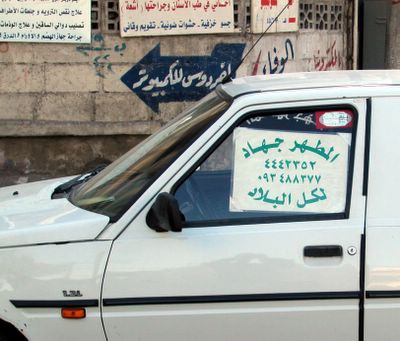
In Damascene tradition, a boy's circumcision used to be an important event attended by family and relatives who fill the house before the arrival of the "circumciser." Enthusiastic visitors shouting greetings and special 'arada songs would make it difficult for the crying poor boy to be heard. After the boy is officially circumcised, he would be proudly paraded in the neighborhood with a red tarboosh on his head and with him holding the white ghallabiyeh robe a few inches away at the front, so that to avoid any possible pain. Today the circumcision is no longer celebrated, as boys are usually circumcised at hospital during their first week of life. However, some people still prefer to do it at home with the help of a "circumciser," like this one announcing his services and cellphone number to passers-by.

8 comments:
A question for people out there. Is there a such a thing in either the Islamic or Arab or Semitic tradition about so-called female circumcision/female genital mutilation. I don't think that it's widely practised in the Arab world east of Egypt apart from some areas of the Jazeera, it's mainly practised in countries such as Somalia, Egypt, Sudan and other north and west African countries!
I find it funny how his sign says "for all the nations".. is he an international circumciser?
I was in Istanbul recently where you can spot the boys en route for their circumcision by their unique outfits.
I recall watching a television programme on the BBC as a youngster, called Schofield's Europe. During his visit to Istanbul he was invited to a 'sunnet' ceremony where the boys were sat on a revolving table and the circumcisor was using a laser gun. His motto was "circumcised on saturday, school on monday!"
"The Circumcisor" sounds like a name for a Hollywood villain. Funny!
Well Bilad can be plural and it can be single. --> hence here it means nation. (Whole nation)
Female circumcision is almost non-existent in Syria. It was subject of great controversy in Egypt a decade ago and was subsequently outlawed. The tradition existed in some parts of the Near East and Africa long before Islam.
He doesn't seem particularly safety-oriented: he's blocking his entire left-side window with that sign!
Excision or (found on the net)
"Female genital cutting, FGC, has been practiced traditionally for centuries. Predominantly found in Africa, it is also prevalent in parts of Southeast Asia and the Middle East. The practice continues, perpetuated through myths, rituals and taboos, even though it has maimed or killed countless women and girls.
Among many cultural and ethnic groups, FGC is inseparable from views of women's social and sexual identity. Also known as female genital mutilation, female circumcision and clitoridectomy, FGC assumes varying forms of severity, the most severe being infibulation, and varying degrees of prevalence, according to culture and region.
An estimated 85 million to 110 million women and girls alive today have undergone FGC..."
Although the operation is irreversible, infibulation can be made less painfull
by minor surgery
Post a Comment